Saturday, June 30, 2018
SCORE LIKE LIONEL MESSI IN VIRTUAL REALITY! - Turbo Soccer VR (HTC Vive + Vive Trackers)
Play virtual reality football like Lionel Messi! Watch Chary try and become as good as him in this VR soccer simulator. Subscribe to join our VR adventures! → https://goo.gl/bSJ6L8 Turbo Soccer is a soccer simulator in VR, where you can feel like a world cup soccer superstar. There are three game modes: Striker, Replay and Goalkeeper. In Striker you are the one that have to shoot the ball in the goal while facing challenges and after beating each challenge it will get more difficult! In Replay you pass the ball to the defenders and put the finishing touch. The last mode is Goalkeeper where you have to save your team by catching the ball! ▶️ Watch another VR sports game (Virtual Sports) → https://www.youtube.com/watch?v=iO3U_2p0f0U ▶️ More HTC Vive (Pro) Gameplays & Reviews → https://www.youtube.com/watch?v=RYl0nceTmYU&list=PL86GNGPnZ0siwDr9AoFLro8NF4CnAqSYx ▶️ More Oculus Rift + Touch Gameplays & Reviews → https://www.youtube.com/watch?v=DKXodZ6Oryg&list=PL86GNGPnZ0sg8QLhWQ9WSnXY4Vyzx-ghA Find Turbo Soccer VR on Steam → https://store.steampowered.com/app/828770/Turbo_Soccer_VR/ ▶️ SUPPORT US * ► VRcovers for your headset → https://goo.gl/U3ZSRD ► HTC Vive (Free Shipping and $50 VIVEPORT Credit) → https://goo.gl/KXdqtG ► HTC Vive Pro → http://bit.ly/2IVLgwS ► Oculus Rift + Touch → https://amzn.to/2qvE3Mo ► Oculus Go → https://amzn.to/2ryrOQx * These are affiliate links. You don't have to use them but if you do, a small referral fee will go to this channel. Supporting the content. If you use it, thanks a lot! ▶️ Or become our Patron (includes exclusive giveaways) → https://www.patreon.com/casandchary ▶️ Join our Discord → https://discord.gg/YH52W2k ▶️ Twitter, Facebook and Instagram → @CasandChary A special thanks to our Patreon Superchamps for their amazing support: - Daniel L. - Ben P. - Wintceas - Baxorn Much love, Cas and Chary VR #turbosoccervr #lionelmessi #soccervr #footballvr #worldcup2018
Oculus Cuts Price on Rift Business Bundle, Now Shipping to Four New Regions
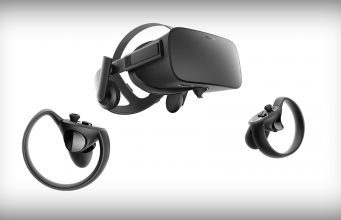
Last October Oculus announced its ‘Oculus Rift for Business‘ bundle, offering for the first time a package which included a warranty and license officially sanctioned for commercial use. This week the company dropped the price of the package and announced availability in four new regions, but China still isn’t on the list.
HTC began offering its own business bundle, the ‘Vive Business Edition’ for $1,200, back in mid 2016, and appears to have taken a strong lead over Oculus in the out-of-home sector. It wasn’t until more than a year later that Oculus followed suite with its own business bundle, which includes the Rift headset, Touich controllers, three sensors extra face cushions, cables, preferential customer support, and a warranty & license allowing for commercial usage.
This week the company announced a price cut of the Oculus Rift for Business bundle from $900 to $800, apparently in an effort to be more competitive against the Vive Business Edition ($1,300) and Vive Pro ($1,600 for the full enterprise package), the latter of which crucially offers an even larger tracking area, making it more suitable for some out-of-home use-cases.
Alongside the price drop, Oculus is now shipping their business bundle to Australia, Japan, New Zealand, and Taiwan, in addition to 17 prior regions. The company is still not offering the bundle (or even the consumer version of the Rift) in China, which has seen a lot of activity in the out-of-home VR space. That policy has made HTC the de facto choice of headset for high-end out-of-home VR deployments in the area.
In addition to the Rift for Business bundle, Oculus also offers a ‘Go for Business’ bundle, a similar commercially focused package for their standalone Go headset.
The post Oculus Cuts Price on Rift Business Bundle, Now Shipping to Four New Regions appeared first on Road to VR.
Ream more: https://www.roadtovr.com/oculus-cuts-price-on-rift-business-bundle-now-shipping-to-four-new-regions/
Watch a Complete ‘Space Junkies’ Closed Beta Match

Space Junkies, Ubisoft’s upcoming VR arena shooter fro Rift and Vive, is now in closed beta, which goes until July 2nd. I called Space Junkies VR’s spiritual successor to Unreal Tournament in our preview, but you can check out some of the real action here in a complete match played by yours truly.
Space Junkies features a bevy of weaponry, giving you two slots for main weapons and two slots for secondary tools/weapons like sonar, a lightsaber, a temporary shield, or and EMP that disables your enemy’s boost.
Starting with a standard repeater pistol, I quickly gravitated towards the larger weapons available: rail guns, gattling guns, and rocket launchers.
Plenty of health and armor is dotted along the way, and two teleport points flank each side of the map: a nice way to surprise, and summarily gank unsuspecting enemies.
I’ve removed some of the downtime from the gameplay video for easier watching. Waiting times in the lobby area can be fairly high if you have to coax unresponsive, or otherwise uncooperative players into the small start area, which is where you vote for maps and generally screw around until the game decides whether you’re in a team deathmatch or a free-for-all.
Matches are five minutes-long, so it definitely presents a good case for short pickup games or long sessions alike. The game doesn’t have an official launch date yet, although Ubisoft’s Montpellier studio maintains it should be out “soon”.
In the meantime check out our preview here. You can also take part in the closed beta too if you’re able to snag an access code. If you can’t get one through official registration, try your luck at the Space Junkies Discord.
The post Watch a Complete ‘Space Junkies’ Closed Beta Match appeared first on Road to VR.
Ream more: https://www.roadtovr.com/watch-complete-space-junkies-closed-beta-match/
Friday, June 29, 2018
Niantic Offers Tantalizing Peek at Upcoming AR Tech, Announces New Platform for Third-party Devs

Niantic, the developer behind Pokémon Go and the upcoming Harry Potter AR game, announced they’ll be opening up access to their latest work in AR, dubbed the ‘Niantic Real World Platform’, to third-party developers soon. To boot, the company also introduced a few key AR technologies that will have you salivating over the possibilities of actually chasing down pocket monsters on your commute to that next Pokéstop.
Niantic says their Real World Platform blends machine learning and computer vision to tackle the classic challenge of building a useful and realistic AR experience on mobile devices—something that can sense small details, understand surroundings, and model them in an interactive 3D space that a smartphone can digest.
One area of research Niantic has been work on is proper occlusion, or making sure digital imagery fits into the physical world correctly, and allowing it to be obscured naturally by objects in the environment. The company published a quick video on their blog, showing off their latest work in the area of AR occlusion. What better test subject than Pikachu?
Creating correct occlusion in AR requires that the computer, in this case a smartphone, contextually understands the world around it. Slowing down the video some, it becomes a little more clear however that the company still has a ways to go, as the occlusion masks oftentimes overcompensate, or misjudge the alignment of objects as Pikachu scampers about. While a proof-of-concept, it’s definitely a tantalizing look at the near future of smartphone AR, and a clear departure from what we saw at Pokémon Go’s launch back in Summer 2016.
The Niantic Real World Platform is also focusing on cross-platform AR for shared, multiplayer experiences. The biggest obstacle, the company says, is invariably latency. To this effect, the company says they’ve developed “proprietary, low-latency AR networking techniques” to overcome this problem, which allowed them to realize a unified, cross-platform solution with a single code base. To demonstrate, Niantic built a multiplayer smartphone AR shooter, dubbed ‘Neon’, which shows six users playing at once.
We can attribute some of this to the company’s recent acquisitions; Niantic recently acquired Escher Reality, a studio touted for its cross-platform, multi-user AR platform, and the computer vision and machine learning company Matrix Mill—two decisive moves forward after the company’s $200 million Series B finance round.
“It’s through the coordination of these teams that we’ve been able to establish what the Niantic Real World Platform looks like today, and what it will be in the future,” Niantic says in a statement.
As for third-party developers looking to get in on Niantic’s platform, the company says they’ll be picking a “handful” of devs to begin working with their tools later this year. To receive more information, sign up here.
The post Niantic Offers Tantalizing Peek at Upcoming AR Tech, Announces New Platform for Third-party Devs appeared first on Road to VR.
Ream more: https://www.roadtovr.com/niantic-offers-tantalizing-peek-upcoming-ar-tech-announces-new-platform-third-party-devs/
Thursday, June 28, 2018
Oculus ‘Medium’ 2.0 Overhauls Performance and Tools, Allows Exporting to ‘Home’

Medium, Oculus’ first-party VR sculpting and modeling tool, today gets a major update in version 2.0, bringing better performance, improved tools, and the ability to export your creations into your own Oculus Home space.
Having launched Medium initially back in late 2016, Oculus has been continuing to tune the tool for the needs of professional artists and modelers. Version 2.0, now available, adds useful tool enhancements like grid snapping and multiple lights, while also bumping the layer limit up to 100. The company also promises improved performance for large and high resolution projects thanks to a new Vulkan-based rendering engine.
Medium 2.0 also brings a new file management system and a “major UI facelift,” designed to help artists work better and faster.
But the tool is also quite approachable by novices, and luckily (since I won’t be sculpting anything worthy of being 3D printed any time soon), Medium 2.0 will allow users to export models directly into their Oculus Home space to show off virtually—a feature that’s been promised for some time.
Oculus says it’s also launching new Medium tutorials as part of the 2.0 update, which will detail new tools like Elastic Move.
Along with the new performance improvements, Medium 2.0 will now require Windows 10, in accordance with the company’s new recommended specifications.
The post Oculus ‘Medium’ 2.0 Overhauls Performance and Tools, Allows Exporting to ‘Home’ appeared first on Road to VR.
Ream more: https://www.roadtovr.com/oculus-medium-2-0-overhauls-performance-enhances-tools-lets-bring-creations-home/
Penalty in Oculus v. ZeniMax Reduced to $250M, Motion to Halt Headset Sales Rejected

Bloomberg reported this week that the $500 million penalty levied at Oculus in last year’s case against ZeniMax has been reduced to $250 million. A motion seeking to prevent sales of Oculus products using code attributed to ZeniMax has been rejected, according to the publication.
ZeniMax took Oculus to court after its acquisition by Facebook in 2014; the company alleged that Oculus stole intellectual property developed by Oculus’ now-CTO John Carmack back when he was employed by ZeniMax’ child company id Software. In the case’s initial verdict back in 2017, the jury awarded ZeniMax $500 million in damages, to be paid by Oculus and key employees. A detailed breakdown of the 2017 verdict is available here.
Citing court documents in the high profile Oculus v. ZeniMax case, Bloomberg reports that U.S. District Judge Ed Kinkeade this week cut down the penalties levied against Oculus company from $500 million to $250 million.
Oculus is still on the hook for $250 million for copyright infringement and breach of contract, as found by the jury, but an additional $250 million penalty for trademark infringement and false designation ($50M against Oculus, $150M against founder Brendan Iribe, and $50 million against founder Palmer Luckey) has been nullified.
According to the report, ZeniMax’s efforts to halt sales of the Oculus Rift and Gear VR (and ostensibly Oculus Go) headsets was rejected by the judge.
The post Penalty in Oculus v. ZeniMax Reduced to $250M, Motion to Halt Headset Sales Rejected appeared first on Road to VR.
Ream more: https://www.roadtovr.com/damages-oculus-v-zenimax-dropped-250-million-motion-halt-headset-sales-rejected/
Wednesday, June 27, 2018
Windows 10 to Become Minimum Supported OS on Rift When Core 2.0 Goes Live

Rift owners still running Windows 7 or Windows 8.1, beware. Oculus is changing both its recommended and minimum supported OS to Windows 10 on Rift, something the company says will come when Rift Core 2.0 is pushed out to the stable branch sometime later this year.
Oculus says in a blogpost that Windows 7 and 8.1 aren’t losing support entirely, but users “may not be able to use many new and upcoming features and apps. We encourage everyone who isn’t already running Windows 10 to upgrade now to avoid missing out on what’s next.”
There is some pretty salient reasoning behind this: the company reports that 95% of “most active Rift owners” currently run Windows 10. Not only that, Microsoft has phased out mainstream support for both Windows 7 and Windows 8.1 now, with 8.1 losing mainstream support as of January 9th, 2018.
Rift Core 2.0 is currently an opt-in beta which puts a few important quality-of-life issues at its core; a customizable Home experience with collectibles, app and window multitasking via Oculus Dash, and Oculus Desktop’s mirror monitors.
Here’s the company’s general warning to users still running Windows 7 and 8.1:
Rift owners whose PCs aren’t running Windows 10 may find their systems are incompatible with some new apps and games. You’ll still be able to get the same VR features and functions you have today, including things like responding to platform notifications, interacting with friends on the platform, managing your device, and running VR apps that don’t require Windows 10. You can still use Windows 7 and Windows 8 with most of Rift Core 2.0’s core functionality, but things like Oculus Desktop require Windows 10, as does the ability to run Dash as an overlay.
Windows 10 has always been a minimum OS for the full functionality of Rift Core 2.0 while in beta, so it makes sense that Oculus would officially have to pull the band-aid off of Windows 7 and 8.1 users eventually.
Oculus hasn’t changed its minimum or recommended hardware specs, which you can see below. If you’re worried your system doesn’t reach the minimum, you can always use Oculus’ compatibility check tool for extra assurance.
Oculus Rift Recommended Specs
- Graphics Card: NVIDIA GTX 1060 / AMD Radeon RX 480 or greater
- Alternative Graphics Card: NVIDIA GTX 970 / AMD Radeon R9 290 or greater
- CPU: Intel i5-4590 / AMD Ryzen 5 1500X or greater
- Memory: 8GB+ RAM
- Video Output: Compatible HDMI 1.3 video output
- USB Ports: 3x USB 3.0 ports plus 1x USB 2.0 port
- OS: Windows 10 operating system
Oculus Rift Minimum Specs
- Graphics Card: NVIDIA GTX 1050Ti / AMD Radeon RX 470 or greater
- Alternative Graphics Card: NVIDIA GTX 960 / AMD Radeon R9 290 or greater
- CPU: Intel i3-6100 / AMD Ryzen 3 1200, FX4350 or greater
- Memory: 8GB+ RAM
- Video Output: Compatible HDMI 1.3 video output
- USB Ports: 1x USB 3.0 port, plus 2x USB 2.0 ports
- OS: Windows 10 operating system
The post Windows 10 to Become Minimum Supported OS on Rift When Core 2.0 Goes Live appeared first on Road to VR.
Ream more: https://www.roadtovr.com/windows-10-become-minimum-supported-os-rift-core-2-0-goes-live/
Why Games As A Service Will Kill Video Games
Continue reading: http://EzineArticles.com/9943729
Oculus Teases New Character for ‘Marvel Powers United VR’, Reveal Coming Tomorrow

Oculus recently teased the next addition to the Marvel Powers United VR lineup, which included the cryptic message “all hail the king,” accompanied by the sound of a large feline growling.
The obvious choice here would be Black Panther, but there is some room for speculation; in the films, T’Challa (Black Panther) eschewed wearing the black and gold suit, instead electing for a muted black and silver color scheme.
— Oculus Rift (@OculusRift) June 25, 2018
If you’re a fan of the film, you’ll remember the main villain Killmonger (played by Michael B. Jordan) took the black and gold Jaguar suit for himself when he ascended the throne of Wakanda. This may be looking too far into it, although the game’s affinity for filling out its cast with less ‘prime time’ characters like Rocket Raccoon, Black Bolt, Crystal, and Captain Marvel decidedly makes a Killmonger reveal a clear possibility.
The game also includes main characters Deadpool, The Hulk, Thor, Loki, and the villain Ronan The Accuser.
Either way, we’ll find out tomorrow, and hopefully have more information on the game’s precise release date. Currently, Marvel Powers United VR is slated to release sometime in 2018, and exclusively on Rift.
The post Oculus Teases New Character for ‘Marvel Powers United VR’, Reveal Coming Tomorrow appeared first on Road to VR.
Ream more: https://www.roadtovr.com/oculus-teases-new-character-marvel-powers-united-vr-reveal-coming-tomorrow/
Google’s ‘Tilt Brush’ Gets New Beginner Mode to Make VR Art Creation Easier

Google’s Tilt Brush (2016) has shaped up to be a fully-featured VR creation tool since the app’s initial launch in April 2016 on HTC Vive, adding things like support for Oculus Rift, integration with Google’s other 3D VR creation tool Blocks (2017), and the ability to export creations to Sktechfab. Now, Google is making Tilt Brush easier with its new ‘Beginner Mode’ so newcomers aren’t so overwhelmed by the app’s growing tools and features.
Now Tilt Brush is divided into an Advanced Mode, and a Beginner Mode, which is set as the default the first time you launch the app. Once you’re ready for more tools, you simply have to toggle Advanced Mode, and you’ll have access to all additional features outside the core tool set.
The latest update also brought with it a number of new effects, tools, and fixes that should make creating things in Tilt Brush an easier experience all around. Here’s a quick list, taken from the Google blogpost announcing the update:
- 12 new brushes – let you create different textures and volumes. With these new brushes, you can create a natural landscape or lifelike characters. One of our favorites is the Hull Brush, which allows you to easily paint three dimensional objects by simply moving your controller.
- New ambiance – If you listen closely, you’ll notice our updated set of sound effects designed to enhance your creation process.
- Sketch organization – We created the Pin Tool so you can quickly lock your objects in place when creating densely populated masterpieces. When you pin objects in place, they are unselectable, making it easier to manipulate the scene around them.
- Mirror tool update – If you lose your Mirror in a busy scene or wander away from it in your sketch, you can click the Recall Mirror Tool to move it right next to you.
- Better object selection – We added new selection features to save you time when editing sketches. You can now select all items in a sketch as well as invert selections that you have made.
- Quicker edits – Iteration has always been an important aspect of the creative process. You can now quickly undo or redo many brush actions by holding the controller button until the scene gets back to the way you want it.
Tilt Brush, once a freebie with purchase of HTC Vive, now sells for $20 on both Steam and the Oculus Store.
The post Google’s ‘Tilt Brush’ Gets New Beginner Mode to Make VR Art Creation Easier appeared first on Road to VR.
Ream more: https://www.roadtovr.com/googles-tilt-brush-gets-new-beginner-mode-make-vr-art-creation-easier/
Tuesday, June 26, 2018
VR Sci-fi Shooter ‘Seeking Dawn’ to Land on Rift & Vive July 12th

Multiverse Inc., the studio behind VR sci-fi shooter Seeking Dawn, today announced the single/multiplayer game is soon heading out of closed beta and launching on Oculus Rift, HTC Vive and Windows “Mixed Reality” VR headsets on July 12th. The studio says support for PSVR is slated to come “later this year.”
Promising a ‘full-length’ VR game, Seeking Dawn is said to offer a 20-hour single-player campaign, co-op gameplay with up to three other players in campaign mode, and multiplayer deathmatches in a “sprawling Survival setting.”



Stepping into the boots of a 23rd century soldier on a hostile planet filled with alien predators and gun-toting enemies, you follow the trail of an allied recon squad to uncover the mystery of why they came (and why they’re gone).
Seeking Dawn is still available for pre-order for $35 on the Multiverse website. Closed beta slots are limited to 500 players. The full release will be available on the Oculus Store (Rift) and Steam (Rift, Vive, Windows VR) for $40.
We haven’t had a chance to step into Seeking Dawn, although gameplay video suggests polished visuals and some fairly Halo-esque gameplay.
The post VR Sci-fi Shooter ‘Seeking Dawn’ to Land on Rift & Vive July 12th appeared first on Road to VR.
Ream more: https://www.roadtovr.com/vr-sci-fi-shooter-seeking-dawn-land-rift-vive-july-12th/
‘Oculus TV’ Brings Live & On-demand Video to Oculus Go, Now Available
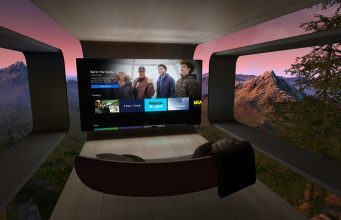
Announced back at Facebook’s F8 developer conference earlier this year, Oculus TV is the company’s latest first-party app that pulls a number of flatscreen video options together under one roof. The app is now available for free on Oculus Go.
Displaying video on a virtual ‘180-inch’ TV, the company is billing its newest video streaming app as the “all-in-one living room solution,” giving Oculus Go users not only native support for live video from Pluto TV, Red Bull TV, and Facebook Video, but it also acts as a launcher for dedicated VR apps such as Netflix, Hulu, Showtime, Newsy, and Neverthink.
Facebook Watch also provides syndicated programming like The Daily Show and Stephen Colbert, and originals programming like Ball in the Family and Red Table Talk.
The company says in a blogpost that a greater expansion of the app’s channel options will be coming throughout the year, which includes ESPN, and other unnamed streaming apps and broadcast partners.
While offering a plush environment to kick back and watch traditional flatscreen media, Oculus TV definitely has a few pain points at launch, like the lack of support for YouTube, and no ‘void’ or comfort view settings that would allow you to watch TV while laying down. Since the app is a single user-only experience, you won’t be able to jump in with friends online either, which isn’t a giant drawback, but would certainly add to the app’s overall utility.
Oculus Go users have a few other options to consider for video watching however. Oculus Video, the company’s first video-viewing app created initially for Gear VR, plays host to local context viewing and livestreaming from Facebook 360 videos, Twitch, and Vimeo. There’s also a PLEX viewer so users can browse their home network’s Plex media server, and Bigscreen Beta, which allow you to mirror your PC’s monitor so you can watch whatever you like. Check out the entire list of
It’s currently uncertain when the Gear VR version of the app is headed down the pipeline. Oculus Go users can download Oculus TV for free here.
The post ‘Oculus TV’ Brings Live & On-demand Video to Oculus Go, Now Available appeared first on Road to VR.
Ream more: https://www.roadtovr.com/oculus-tv-brings-live-demand-video-oculus-go-now-available/
Oculus Go Now Available from European & Canadian Retailers, In-store & Online
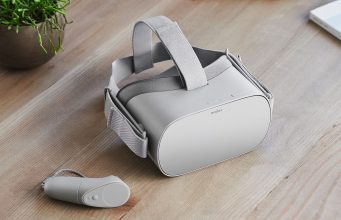
Oculus Go, the company’s $200 standalone 3DOF headset released last month, is finally available through Oculus retail partners in Europe and Canada. Online availability is fairly wide-spread, while some brick-and-mortar locations now have the headset in stock on store shelves.
Update (June 26th, 2018): Oculus Go is now available via Canada and European retailers. We’ve update the list below to include countries previously missing from Oculus’ initial availability announcement.
Original article (June 2nd, 2018): European residents have (mostly) been able to order Oculus Go directly through the Oculus website since it launched early last month, with the company delivering to many countries in the EU and Schengen Zone including Austria, Belgium, Denmark, Finland, France, Germany, Ireland, Italy, Netherlands, Norway, Poland, Spain, Sweden, Switzerland, and the UK.
Come June 26th, residents of the UK, France, Germany, Netherlands, and Switzerland (and more, see update) will be able to walk into a brick-and-mortar shop and snag one off the shelves. Touted as a low-price, high-quality mobile VR headset, Oculus Go is available in two types: a 32GB version for €220/£200, and a 64GB version for €270/£250.
Check out the in-store and online availability below:
UK Store Availability
- Argos
- Dixons (including Currys and PC World)
- Amazon
- Dixons Travel
- Harrods
- Littlewoods.co.uk
- very.co.uk
Germany Store Availability
France Store Availability
Other Countries
- Canada – Best Buy
- Austria – MediaMarkt
- Belgium – Cool Blue
- Italy – Amazon
- Netherlands – CoolBlue
- Switzerland – Digitec
- Spain – Amazon
If you’re outside the countries above, remember that many Europe-based Amazons deliver outside their official area of service, including many countries in the EU not listed above.
The post Oculus Go Now Available from European & Canadian Retailers, In-store & Online appeared first on Road to VR.
Ream more: https://www.roadtovr.com/oculus-go-hit-uk-european-retailers-month-pre-orders-now-available/
Monday, June 25, 2018
Motion Platform Company ICAROS Takes on ‘Seven Figure Investment’ to Advance VR Heath Device
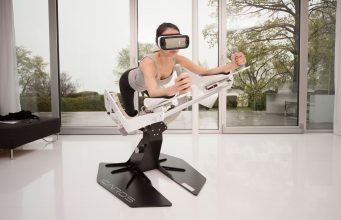
ICAROS is a Munich-based VR health startup that produces a unique motion platform which simulates flying in the prone position, something the makers say can provide a real workout. The company recently announced it’s completed a funding round in the “mid-seven figures” from Austrian private venture company Segnalita.
The system is composed of the Icaros motion platform and integrated controller, and includes dedicated apps supporting Samsung Gear VR, HTC Vive, and Oculus Rift. The company’s apps include VR experiences such as flying, diving, free falling or competing with other Icaros pilots all over the world in the company’s own ICARACE, a multiplayer online race.
The company’s latest financing round will allow them to “tap into new markets and, above all, to advance our research and development work in the health segment,” says Icaros co-founder and CEO Michael Schmidt. Financing is also earmarked to help productize the Icaros consumer version (Icaros Home) for its Summer 2018 launch, and continue development of its online platform.
While it sounds like fun and games, the company says its ultimate vision is to “provide the most motivating and health promoting training experiences to combat our society’s sedentary lifestyle,” saying that the system is already is use in the health sector in areas such as physiotherapy.
“ICAROS provides completely unique, promising products that brilliantly combine sports, fitness and gaming, which is very much in line with the times. We are now enabling the company to keep growing within the existing segment and make the products accessible in the medicine sector,” said Bernhard Letzner, managing director of Segnalita.
The company’s enterprise-focused device, Icaros Pro, starts at €8,400 (~$9,800) before taxes and shipping. There’s currently no public pricing available on the upcoming consumer version Icaros Home, although we’re hoping to learn more when it releases this summer.
The post Motion Platform Company ICAROS Takes on ‘Seven Figure Investment’ to Advance VR Heath Device appeared first on Road to VR.
Ream more: https://www.roadtovr.com/motion-platform-company-icaros-takes-seven-figure-investment-advance-vr-heath-device/
Telekinetic Puzzle ‘Esper’ to Launch on PSVR & Oculus Go This Week, HTC Vive in July

Coatsink, the studio behind VR titles A Night Sky (2017) and Augmented Empire (2017), announced they’re bringing their first mobile VR title, Esper (2015), to PlayStation VR, Oculus Go and Xiaomi Mi on June 29th. Esper is also slated to launch on HTC Vive via Steam on July 6th.
As one of the first great titles on Samsung Gear VR, Esper puts you in the shoes of a not-so-ordinary citizen undergoing an aptitude test to determine if you can control your rare and potentially threatening extra-sensory telekinetic abilities—moving things with your mind. Using your gaze to control objects including balls and blocks, you’re urged to solve a number of puzzles, all the while chided by an E.S.P.R. training program instructor.
Esper is already available on Gear VR, Microsoft “Mixed Reality” VR headsets, and as part of Esper The Collection on Oculus Rift, which includes Esper and its sequel Esper 2 (2015).

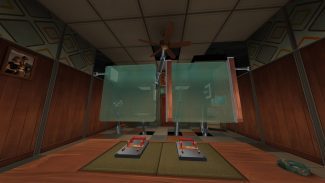

“Esper is where the VR journey began for Coatsink and it holds a dear place in our hearts. Having Oculus approach us in the early days of modern day VR and trust our then small team to build and create an acclaimed VR game for Gear VR was nothing short of incredible,” said Coatsink CEO Tom Beardsmore.
Esper will launch on Oculus Go, PSVR and HTC Vive for $8.
The post Telekinetic Puzzle ‘Esper’ to Launch on PSVR & Oculus Go This Week, HTC Vive in July appeared first on Road to VR.
Ream more: https://www.roadtovr.com/telekinetic-puzzle-esper-launch-psvr-oculus-go-week-htc-vive-july/
HTC Donates Over 100 Vive Headsets to California & Nevada Libraries
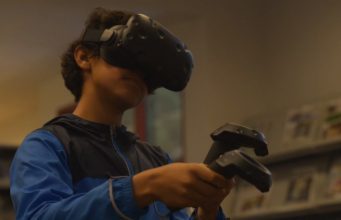
HTC is donating over 110 HTC Vive systems to California and Nevada libraries through its new Vive Libraries Program, an effort to seed local communities with premium VR.
In a blogpost announcing the program, HTC’s Chris Chin, Executive Director of Education VR Content, said he’s “especially excited that VR is entering communities that traditionally have had social, economic, or other access barriers.”
In California alone, HTC has donated 100 Vive headsets to public libraries.
“This generous contribution by Vive is helping bring a virtual world of adventure and learning to communities across California. As more virtual reality stations take root across our library system, we are seeing positive learning impacts and visitors that are genuinely excited about technology and education,” said California State Librarian Greg Lucas.
The company has invested heavily in the areas of education and the arts, including a multi-million dollar arts program, which saw partnerships with museums across the globe including London’s Tate Modern, New York’s Metropolitan Museum of Art, Paris’ Natural History Museum—and their China-based, multidisciplinary VR educational programs via their startup VIVEDU, which has brought HTC VR products to Chinese classrooms spanning the gamut of K-12, vocational schools and university-level classes.
Through HTC’s content platform Viveport, the company is presenting libraries with over 35 educational experiences covering the areas of Arts & Culture, Creativity, Design, History, STEM, Travel, and Wellness. Check out the full list of experiences below.
Vive Libraries Program Content List
- Adventures in Space
- Amazon Odyssey
- Ancient Adventures
- Berlin Wall: The Virtual Reality Experience
- Beyond Tokyo
- Buzz Aldrin: Cycling Pathways to Mars
- Calcflow
- COSM Worlds within Worlds
- Earthlight VR: Spacewalk
- Everest VR
- Jam Studio VR
- Lifeliqe VR Museum
- Lumen
- Lunar Learning & Earthly Robots
- MakeVR Pro
- Mars Odyssey
- Masterpiece VR
- Masters of Design
- Modigliani VR: The Ochre Atelier
- Newton’s House of Forces
- Oceans of Wonder
- Operation Apex
- Rad Robots
- Realities.io
- Remembering Pearl Harbor
- Remind VR: Daily Meditation
- SculptrVR
- Stonehenge VR
- Super Puzzle Galaxy
- Take Flight!
- The Night Cafe: A VR Tribute to Van Gogh
- The Physiology of the Eye
- TrueScale
- Unabomber: The Virtual Reality Experience
- Unbound
- Wisemind
The post HTC Donates Over 100 Vive Headsets to California & Nevada Libraries appeared first on Road to VR.
Ream more: https://www.roadtovr.com/htc-donates-100-vive-headsets-california-nevada-libraries/
Saturday, June 23, 2018
WHAT AM I DOING TO MY VR GIRLFRIEND?! - VR Kanojo Gameplay (HTC Vive Pro)
Cas is not home... So I'm spending my day with my anime girlfriend in VR girlfriend simulator: VR Kanojo. Subscribe to join our VR adventures! → https://goo.gl/bSJ6L8 Okay, not sure what I was doing in this video... Please don't judge!! Haha, all jokes aside... VR Kanojo is a VR girlfriend simulator where you are placed in the bedroom of a girl who is madly in love with you. I think... I’m not even sure, I’m still feeling a bit awkward after playing... hahaha... ▶️ Watch another VR girlfriend simulator game (Together VR) → https://youtu.be/FBHU_-jB1pI ▶️ More HTC Vive (Pro) Gameplays & Reviews → https://www.youtube.com/watch?v=RYl0nceTmYU&list=PL86GNGPnZ0siwDr9AoFLro8NF4CnAqSYx ▶️ More Oculus Rift + Touch Gameplays & Reviews → https://www.youtube.com/watch?v=DKXodZ6Oryg&list=PL86GNGPnZ0sg8QLhWQ9WSnXY4Vyzx-ghA Find VR Kanojo on Steam → https://store.steampowered.com/app/751440/VR_Kanojo__VR/ ▶️ SUPPORT US * ► VRcovers for your headset → https://goo.gl/U3ZSRD ► HTC Vive (Free Shipping and $50 VIVEPORT Credit) → https://goo.gl/KXdqtG ► HTC Vive Pro → http://bit.ly/2IVLgwS ► Oculus Rift + Touch → https://amzn.to/2qvE3Mo ► Oculus Go → https://amzn.to/2ryrOQx * These are affiliate links. You don't have to use them but if you do, a small referral fee will go to this channel. Supporting the content. If you use it, thanks a lot! ▶️ Or become our Patron (includes exclusive giveaways) → https://www.patreon.com/casandchary ▶️ Join our Discord → https://discord.gg/YH52W2k ▶️ Twitter, Facebook and Instagram → @CasandChary A special thanks to our Patreon Superchamps for their amazing support: - Daniel L. - Ben P. - Wintceas - Baxorn Much love, Cas and Chary VR #vrkanojo #kanojo #vr #vrgirlfriendsimulator
Friday, June 22, 2018
Steam Summer Sale Offers Big Discounts on Top VR Titles

Steam’s annual summer sale is back, and heavy discounts are here on hundreds of VR games including a number of top titles that will have you spending those hot days in the cold depths of space, post-apocalyptic warzones, and practically anywhere you can imagine that isn’t your backyard.
Both Oculus and Viveport’s respective sales are still on, but the motherlode of sales is here too to draw your well-earned bucks from that shabby velcro wallet of yours. Here’s a few notable titles divided by price range which are currently on sale, effective from June 21st to July 5th:
Under $15
- The Forest
$20$13 - Elite Dangerous
$30$13.50 - Keep Talking and Nobody Explodes
$15$6 - Space Pirate Trainer
$15$7.50 - Smashbox Arena
$20$5 - Final Approach
$15$7.50 - Dreadhalls
$10$7 - Serious Sam 3 VR BFE
$40$10 - In Death
$20$13 - Vanishing Realms
$20$14 - Thumper
$20$8 - FORM
$15$8 - DiRT Rally
$60$12
$15 to $30
- Rez Infinite
$25$15 - Onward
$25$15 - The Talos Principle VR
$40$20 - Sairento VR
$30$22.50 - I Expect You to Die
$25$15 - Sprint Vector
$30$21 - Subnautica
$25$20 - GORN
$20$15 - The Invisible Hours
$30$15 - Payday 2: Ultimate Edition
$80$15 - Project Cars 2: Game of the Year Edition
$82$20
Over $30
- Ubisoft VR Bundle (Star Trek Bridge Crew, Eagle Flight, Werewolves Within)
$110$36 - The Elder Scrolls V: Skyrim VR
$60$42 - Fallout 4 VR
$60$42 - Crowteam VR Bundle (The Talos Principle VR, Serious Sam VR 1-3, Serious Sam VR: The Last Hope)
$200$35 - X-Plane 11
$60$40
Don’t see a game you want on the list? Check out all VR games on sale right now here. Remember, the sale goes on from June 21st to July 5th, so prepare our lunch money accordingly.
The post Steam Summer Sale Offers Big Discounts on Top VR Titles appeared first on Road to VR.
Ream more: https://www.roadtovr.com/steam-summer-sale-offers-big-discounts-top-vr-titles/
Valve Announces ‘Skeletal Input’ to Give SteamVR Apps More Lifelike Hands Moving Forward

Accompanying the news that Valve has made a critical redesign of its ‘Knuckles’ motion controller, the company also recently released a new input system in beta that not only aims to create lifelike hands, but make them accessible to all SteamVR app developers.
There’s a few ways current VR controllers can be used to estimate where a user’s fingers are at any given moment; integrated touchpads, button presses, or resting fingers on integrated capacitive sensors, which can sense when a finger or palm is touching a part of the controller or not—all of these data points can be translated into hand models with varying degrees of success.
With Valve’s new input system, dubbed SteamVR Skeletal Input, the company is essentially giving app developers a ready-made set of lifelike skeleton-based hand animations that support a number of existent controllers: Vive controllers, Oculus Touch, and the new Knuckles EV2 design. More importantly though, Valve is putting the onus on hardware manufacturers to add support for the Skeletal Input system to their new controllers, and not the individual app developer.
This comes as a big next step following Valve’s recently released SteamVR Input system, which lets users remap button configurations and allows developers to more easily support existing and future controllers. Knuckles EV2, for example, not only contains a touchpad, a joystick, trigger and buttons, and a number of capacitive sensing areas, but also a new force sensor, which detects actual grip force, and a track button which also has a force sensor.
Valve says in a blogpost that the system its providing two basic possibilities for hand animations: one for a more accurate controller-in-hand animation, and another where hands are empty and a controller isn’t being rendered in-app. Check out the examples below of what the Knuckles EV2 looks like with and without the controller.
Valve’s new SteamVR Skeletal Input system will also lets app devs mashup their own hand animations with the predefined examples by using one of the other in any given moment, giving hands the full range of motion as needed.
Valve says a the full release is coming “soon,” and that currently only Unity developers can access the Skeletal Input API with the early release of the SteamVR Unity plugin. Documentation is now available on the OpenVR GitHub Wiki.
Valve’s emphasis on “skeletal input” over ‘hand input’ is an interesting word choice. While the system does indeed aim to replicate models based off a simulated skeletal structure of the hand, it’s easy to imagine the system continuing its growth alongside more sophisticated tracking hardware with more tracking points, eventually providing an entire skeletal model of the human body as a standard for app developers. Whatever the case may be, with Valve integrating Skeletal hand tracking and smooth animations at the core of SteamVR means we may at very least say goodbye to blocky, lifeless VR hands for good.
The post Valve Announces ‘Skeletal Input’ to Give SteamVR Apps More Lifelike Hands Moving Forward appeared first on Road to VR.
Ream more: https://www.roadtovr.com/valve-announces-skeletal-input-give-steamvr-apps-lifelike-hands-moving-forward/
Thursday, June 21, 2018
Rift & Vive Summer Sales Offer Big Savings on Hundreds of VR Titles

While we’re still waiting on the Steam Summer Sale to materialize, this year’s big Rift and Vive annual summer sales are already here, and hundreds of VR titles are on deep discount on the Oculus Store and Viveport until the beginning of next month.
Many of the top VR games from 2016 and 2017 are hovering around half price for the next week, so check out some of the notables below to get a good idea of what’s in store.
Oculus Store Summer Sale
Here’s a few notable titles on sale on the Oculus Store, valid until through 11:59 pm PT on July 1st (local time). Don’t forget to check out the full list of Rift titles on sale at the Oculus Store.
- Rez Infinite
$25$15 - Island 359
$25$15 - The Gallery – Episode 1: Call of the Starseed
$20$5 - The Gallery – Episode 2: Heart of the Emberstone
$30$18 - Windlands
$20$8 - Red Matter
$35$26 - Chronos
$40$20 - Apex Construct
$30$20 - Edge of Nowhere
$30$14 - Dirt Rally
$25$13 - Brass Tactics
$40$26 - In Death
$20$13 - The Unspoken
$20$10 - Arizona Sunshine
$40$25 - Killing Floor: Incursion
$30$17
Viveport Summer Sale
Here’s a few notable titles on sale on Viveport, valid until July 8th (no specific end time listed). Don’t forget to check out the full list of Vive titles on sale through Viveport.
- Knockout League
$30$20 - Twisted Arrow
$20$10 - Apex Construct
$30$20 - Sairento VR
$30$23 - Cosmic Trip
$20$10 - Make VR Pro
$40$10 - Make VR
$30$5 - Apollo 11 VR
$10$5 - Skyfront
$20$10 - Island 359
$20$10 - Kittypocalpyse
$15$8 - Ultrawings
$25$13 - Cosmic Trip
$20$10 - Prison Boss VR
$20$10
The post Rift & Vive Summer Sales Offer Big Savings on Hundreds of VR Titles appeared first on Road to VR.
Ream more: https://www.roadtovr.com/rift-vive-summer-sales-offer-big-savings-hundreds-vr-titles/
Wednesday, June 20, 2018
‘Echo Combat’ Open Beta Weekend Starts Tomorrow on Rift
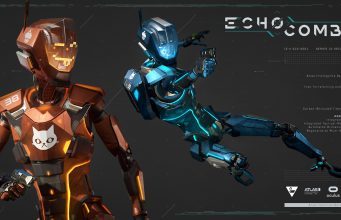
If you didn’t get a chance to jump into the closed beta last month of Echo Combat, the upcoming online shooter expansion to Ready at Dawn’s Echo Arena (2017), then you’ll certainly have a chance this weekend, as the studio is opening up their pod bay doors to all Rift users starting tomorrow.
Echo Combat throws you into a beefier combat-ready avatar with a few guns and secondary weapons at your disposal. Offering a payload-based objective, much like the gametype in Team Fortress 2 (2007) or Overwatch (2016), you push the the cart on a track through the winding maze as an attacker, or defend the advances of the cart by pushing it backwards and running down the three-minute game clock. Check out our full hands-on from the closed beta for a better idea of what to expect.
While the game is bound to be slightly different this time around thanks to new secondary weapons such as a shield and another explosive devices, we expect much of the gameplay to be the same, albeit with many more players to test the limits of Ready at Dawn’s servers.
Echo Combat will be hosting a three-hour community event to kick off the open beta weekend, which starts Thursday, June 21st at 10:30am PT (local time) through Sunday, June 24th at 10:00am PT (local time).
Check out Echo Combat on the Oculus Store here. The full release is slated to cost $10, so now is a great time to find out if the zero-G shooter is right for you.
The post ‘Echo Combat’ Open Beta Weekend Starts Tomorrow on Rift appeared first on Road to VR.
Ream more: https://www.roadtovr.com/echo-combat-open-beta-weekend-starts-tomorrow-rift/
‘Arizona Sunshine’ Dead Man DLC for PSVR Pushed Back to July
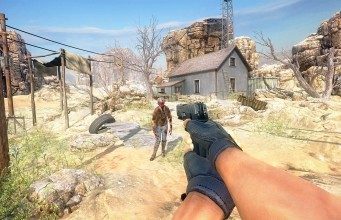
Arizona Sunshine (2016), the room-scale zombie shooter adventure, already got its first campaign DLC on Oculus Rift, Vive & Windows “Mixed Reality” VR headsets on May 24th, dubbed ‘Dead Man’ DLC. The single mission campaign, which was previously targeting a June release on PSVR, is now pushed back to July.
Update (06/20/18): Vertigo Games and Jaywalkers Interactive recently released word via a Facebook post that Arizona Sunshine’s Dead Man DLC for PSVR is now due for a July launch. The DLC, which is a prequel to the series, will be on offer for $2.50. The studios said the delay is due to an unspecified “technical challenge,” that has since been solved.
The original article detailing Dead Man DLC follows below:
Original article (05/04/18): Dropping you in a zombie-infested US missile base, you’re tasked with containing the fresh zombie outbreak. Assuming the role of Dockson, a US Army Special Forces corporal, your mission is to launch a nuclear-warhead loaded missile to clear the base, and of course dispatch all of the zombies between you and the launch silo.
Arizona Sunshine: Dead Man DLC is already on Steam, and will be available for $2.50.


The single mission campaign takes place before the events of Arizona Sunshine. Just like its predecessor, it boasts both single player and online co-op for up to two players.
To boot, there are also three new weapons: a fully automatic submachine gun, a two-handed shotgun and a tactical handgun. Dead Man DLC features various difficulty levels including Apocalyptic Mode, something Vertigo Games says is “insane.”
Dead Man DLC also includes new masks and “a couple of light customization options” as well. Six new achievements will also be available for the rabid completionists out there.
The post ‘Arizona Sunshine’ Dead Man DLC for PSVR Pushed Back to July appeared first on Road to VR.
Ream more: https://www.roadtovr.com/arizona-sunshine-receive-dead-man-dlc-may-24th-psvr-support-june/
Beyeonics Raises $11.5M to Further Develop AR/VR Surgical Visualization Platform

Elbit Systems, an Israel-based defense company, recently announced that its medical technologies subsidiary Beyeonics Surgical successfully concluded its first funding round of $11.5 million, which the company says will be used to expand product development and accelerate commercialization of its surgeon-centric AR/VR technologies.
Founded in 2012 by Elbit senior engineers, Beyeonics is developing its Clarity Bionic Visualization Platform, an AR/VR solution designed to provide surgeons with visualization tools that effectively replace surgical microscopes while allowing real-time integration of relevant data.
According to the company’s press release announcing the $11.5 million venture capital round, the Clarity platform is said to use what the company calls its ‘Transparent Head Wearable Display’ that utilizes a “unique Elbit Systems’ displays technology, 3D Ultra-Resolution remote sensing cameras, and a Processing Core.”
Elbit says the Clarity platform has undergone clinical testing since 2016, and has been used in more than 20 eye surgeries both at the Tel Aviv Sourasky Medical Center and at Retinal Consultants of Arizona. The company also develops solutions for spinal surgery, minimal invasive procedures, robotic surgery, and tools for use in cardiovascular catheterization labs.
Elbit hasn’t specified the parties involved in the funding round, although the company says the investment came from “leading investment groups including an international corporation.”
“Having completing this funding round on the heels of Cyberbits’ investment announcement, attests to the commercial potential of our technologies,” said Bezhalel Machlis, President and CEO of Elbit Systems. “We are proud to have spun-off a company that leverages some of our unique technologies to materially enhance surgeons’ capabilities in the operating room.”
Beyeonic’s parent company Elbit develops a wide range of defense technologies including homeland security and commercial programs operating in the areas of aerospace, land and naval systems, intelligence surveillance and reconnaissance, and unmanned aircraft systems.
The post Beyeonics Raises $11.5M to Further Develop AR/VR Surgical Visualization Platform appeared first on Road to VR.
Ream more: https://www.roadtovr.com/beyeonics-raises-11-5m-develop-ar-vr-surgical-visualization-platform/
Tuesday, June 19, 2018
Designing ‘Virtual Virtual Reality’, One of Mobile VR’s Most Immersive Games Yet

Launched initially on Daydream in early 2017, and now available on Gear VR, Oculus Go, and Oculus Rift, Virtual Virtual Reality’s smart interaction design gives players freedom and control which—combined with a narrative tying it all together—makes Virtual Virtual Reality one of the most immersive mobile VR games to date. This guest article by Mitch Mastroni, Interaction Designer at Tender Claws, the studio behind the game, explores how the game achieved significant immersion even on more restrictive mobile VR headsets.
Guest Article by Mitch Mastroni
Mitch Mastroni is an Interaction Designer at Tender Claws, where he handles all aspects of systems design and programming across both VR and AR experiences. He pulls from his background in performance art—ranging from improv comedy to jazz percussion—to create compelling interactive experiences. He holds a B.S. in Computer Science: Game Design from UC Santa Cruz, where he developed the 2016 IndieCade finalist Séance. You can find him in the corner of a networking event, waxing poetic about theme park design.
Our game Virtual Virtual Reality is a comedic adventure that is both love letter to VR and playful commentary on the tech industry. Players are welcomed by their manager Chaz to Activitude, a virtual service where humans are tasked with assisting AI clients. These AI, which appear in various forms ranging from a tempermental artichoke to a demanding stick of butter, have increasingly bizarre requests for the player to perform. The story unfolds as the player travels between virtual realities, diving deeper and deeper into the machinations of Activitude.
If you haven’t had a chance to play Virtual Virtual Reality, check out the trailer below to get a taste of the game, which also recently launched on the Oculus Rift:
Object Interaction: The Leash
When players pick up objects in Virtual Virtual Reality, they see a curved line connecting their VR controller to the object in question. This ‘leash’ is the only tool that players have at their disposal for the full duration of the game. All other object interactions in the game (plugging a plug into a socket, watering flowers with a watering can, etc.) are performed with the leash. Even simple interactions—like tossing a ball in the air or dragging your manager by his robotic legs—are very satisfying to perform with the leash.
The leash helps the player understand the relationship between the controller’s movement and the object’s movement. It also enhances game feel by giving virtual objects weight. Instead of instantly moving the object to the position where the player’s controller is pointing, the leash applies a constant force to the object in the direction of that position. Heavier objects will take longer to arrive at their destination and will sag the leash downwards. By swiping the trackpad forward and backward, players can also push and pull objects towards and away from themselves, enabling 6DOF object control from a 3DOF controller.
Virtual Virtual Reality was originally developed for Daydream VR and its 3DOF controller, leading us to consider control schemes found on other devices with 3DOF controllers (see this article for an introduction to 3 DOF vs 6 DOF ). We were inspired by the ‘Capture Gun’ in Elebits, Konami’s 2006 Wii-exclusive title. Elebits achieved a surprisingly intuitive use of the 3DOF Wiimote that we had yet to see implemented in any game: VR or otherwise. We were pleasantly surprised to find that the leash is also comfortable while using multiple controllers and 6DOF controllers. We designed unique visual and haptic feedback for the leash to fit each of Virtual Virtual Reality’s platforms and to leverage their respective control schemes.
The choice of the leash was also informed by the distance between players and the objects that they interact with. Early VR experiments at Tender Claws resulted in us constraining object interactions to the “mid-range.” Most objects that the player grabs are at least one meter in front of the them and and no further than six meters away. This tends to be the most comfortable range for modern VR headsets. Some players have trouble focusing on objects closer than one meter. Further than six meters away, there is no clear sense of depth and small objects are clearly pixelated. The leash closes the mental gap between the player and their object of focus, allowing that object to become an extension of the player.
World Interaction: Headsets
The most recognizable gameplay mechanic of Virtual Virtual Reality is the ability to put on and take off any VR headsets in the game at any time. Virtual reality inside of virtual reality. Yes, in fact, it is kind of like Inception.
Early into our development of the headset transition mechanic at a 2015 hackathon, we realized that the experience of taking off and putting on headsets had potential beyond a narrative framing device. We wanted players to interact with headsets as often as possible.
One key characteristic of headset transitions is that they are completely seamless without any perceivable loading time. To achieve this, every accessible virtual reality, or level, is loaded into memory before its associated headset appears. Although this required significant performance optimizations to reduce the memory footprint of each level, it also lead us to an artistic direction that reduced the workload of our artists.
We experimented with various visual transitions to reduce the jarring effect of leaving one level and entering another. Ultimately we chose a fisheye lens effect that warps the edges of the screen, paired with a single frame cut between the two levels at the peak of the warping. The fisheye effect is accomplished through the use of a vertex shader: the geometry of the world is actually stretched away from the player to emulate the familiar look.
The interaction language and logic is consistent for the VR headsets in the game. They can be picked up like any other object in Virtual Virtual Reality. To take off their current headset, the player points their controller at their head and grabs that headset. Drawing attention to the presence of the player’s real headset does not compromise immersion, in fact it reinforces their connection to the experience.
We decided that the action of moving between virtual realities should be a valid choice at any point. Any headset in the game can be picked up and put on, and at any point you can take off your current headset to ‘go up a level’. These choices are also recognized and validated by other systems in the game. For example, characters will comment on you leaving and returning to their virtual realities, which helps reinforce the relationship between the headset system and the narrative.
Localization and Subtitles
We began the process of localizing Virtual Virtual Reality into eight languages after the game launched on Daydream. The spoken and written words of Virtual Virtual Reality are central to the experience and we wanted to give more players an opportunity to comfortably enjoy the game.
The decision to use subtitles instead of recording dialogue in new languages was a matter of resources and quality control. We worked with an extremely talented cast of voice actors who recorded over 3,000 lines of dialogue to bring the characters of Virtual Virtual Reality to life. The task of re-recording and implementing that dialogue in eight additional languages was simply beyond the scope of our team. Instead, we focused our efforts on creating the best subtitle system ever conceived by god or man. Or at least by a mobile VR game in 2017.
The Virtual Virtual Reality subtitle system was designed with two guiding principles. First, subtitles should be comfortably visible at all times. Second, it should always be clear who is speaking. Neither of these are novel concepts (see the game accessibility guidelines and this excellent article by Ian Hamilton), but at the time of development there were virtually no examples of these principles being applied in VR.
The key to our approach is dynamic positioning. The subtitles are repositioned to best fit the direction that the player is looking. When the player is looking at a speaking character, the subtitles appear directly below that character. When the player is looking elsewhere, the subtitles appear at the bottom of the player’s view with an arrow pointing in the direction of the character. The arrow is particularly helpful for players who are hard of hearing. Subtitles smoothly transition between the two states so that reading is never interrupted. Scenes with multiple speaking characters utilize different colored text for additional clarity.
Next Steps
Designing Virtual Virtual Reality was an incredible learning experience for our whole team. We all have backgrounds in gaming but none of us had ever worked on anything quite like this—a dense three-hour narrative adventure in VR. We are currently working on several new projects that leverage our lessons learned from Virtual Virtual Reality and further our integration of systems and narrative. The state of interaction design ih VR has come so far in the past few years, and we’re excited to continue exploring and innovating as we create new experiences.
The post Designing ‘Virtual Virtual Reality’, One of Mobile VR’s Most Immersive Games Yet appeared first on Road to VR.
Ream more: https://www.roadtovr.com/designing-virtual-virtual-reality-mitch-mastroni-tender-claws/
At $600K, Tundra Tracker Smashes Kickstarter Goal in Less Than 24 Hours
Tundra Tracker, the SteamVR Tracking tracker in development by Tundra Labs, has well exceeded its $250,000 Kickstarter goal in less than 2...
-
DOOM 3 VR Edition launches today on PlayStation consoles, bringing the 2004 classic horror-shooter to PSVR for the first time. We haven...
-
Tundra Tracker, the SteamVR Tracking tracker in development by Tundra Labs, has well exceeded its $250,000 Kickstarter goal in less than 2...
-
InXile Entertainment, the studio behind The Mage’s Tale (2018) and The Bard’s Tale series, today announced Frostpoint VR: Proving Ground...